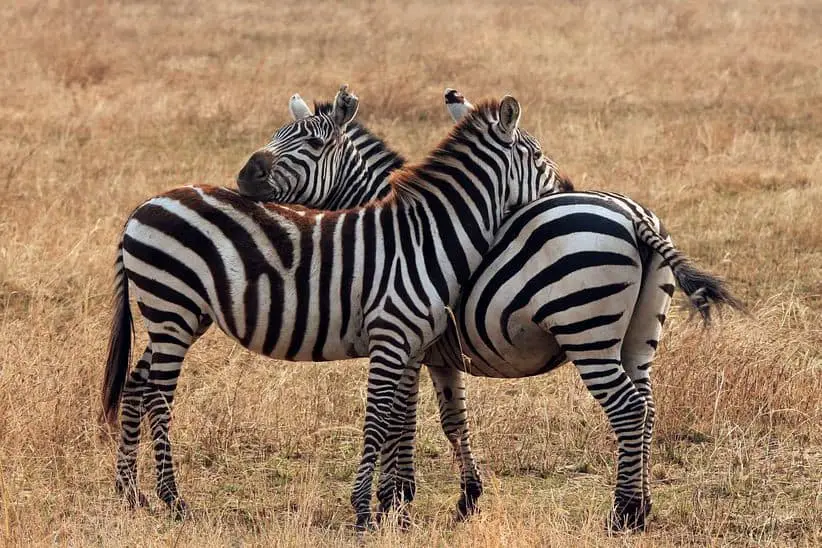
Zebras are some of the most iconic animals in Africa but did you know that they are actually also quite intelligent animals, especially when it comes to the important skills required for surviving?
Zebras are very smart where it counts. They are excellent at locating sources of water and fresh, green grass which is essential for them. They are also great at avoiding predators and defending themselves when necessary.
Keep reading to find out exactly what makes zebras so smart. Did you for instance know that they will travel hundreds of miles to find the best sources of water and grass, or that they have some fascinating abilities that help them stay safe from predators? In this post, we explore these fascinating abilities in great detail.
Zebras Know When and Where to Go For Green Grass and Water
Zebras’ digestive systems do not allow them to obtain nutrients as efficiently as some other herbivores (giraffes, for instance), so they need to spend upwards of 19 hours per day eating. Their digestive systems are, however, extremely efficient at obtaining nutrients from old, dry grass which makes them unique from most other herbivores.
When zebras eat the old, dry grass in an area, they make room for fresh, green grass to grow which is not only beneficial for the zebras but also a wide variety of other herbivores including wildebeests, giraffes, and several species of antelopes. Zebras are actually very important for certain African ecosystems as they are often the first animals to migrate to areas with old, dry grass and after they have done their work, many other animals will migrate to the area.
While zebras can obtain nutrients from old, dry grass, they certainly prefer fresh and green grass since it is much more nutritious and also contains much more water which is also essential for the zebras. In most of Africa, green grass actually makes up around 90% of the food for zebras.
Zebras are extremely good at locating sources of water and fresh grass and they will sometimes travel hundreds of miles to find areas that can provide them with bountiful sources of water and green grass, for instance from the Serengeti National Park in northern Tanzania to the Maasai Mara National Reserve in Kenya.
These long journeys are often referred to as the great migration and if you are lucky, you can see giant groups (called dazzles) of zebras consisting of hundreds of animals traveling together in the search of areas with water and fresh grass.
These massive dazzles of zebras are temporary and usually only occur for these great migrations but they are certainly an incredible thing to see.
When zebras go on these long journeys, they actually also often travel with other species of animals. Wildebeests are especially common to see on these great migrations. One of the most important reasons why traveling together with other species of animals is smart for zebras is that it provides better protection from predators such as lions, leopards, cheetahs, and hyenas since a larger group of animals is much more dangerous to attack than a small of group of animals.
This brings us to the next reason why zebras are smart animals.
Zebras are Always Prepared for Dangerous Situations

Zebras are always looking out for predators such as lions, leopards, cheetahs, and hyenas.
Zebras spend upwards of 19 hours per day eating and since upwards of 90% of their food comes from grass, they keep their heads very close to the ground for a large amount of the time. This makes them vulnerable to predators as they are not able to keep an eye out for danger while also having their heads at ground level.
Zebras have developed several smart ways to increase their safety from predators such as lions, leopards, cheetahs, or hyenas when they eat.
Zebras often take turns when they eat so when you see a group of zebras, oftentimes many of them will be eating while a few of them are looking out for predators and after some time, they will switch so they all get to eat. This behavior can be seen in the first image in this post.
Another smart thing zebras do to increase their safety from predators is one we have already briefly mentioned and that is that they often stay together with other animals such as wildebeests and giraffes. Sure, staying in large groups requires areas with much more water and grass and is not always a viable option, especially during droughts, but it certainly also provides some good protection since predators usually prefer to hunt animals that have been separated from their group since they are much less dangerous to hunt.
Zebras have also developed some excellent strategies for protecting the young and the weak when they are under attack by predators. They will for instance often form a circle around the most vulnerable members of the group if needed since this reduces the risk of being hunted significantly.
Zebras can kick and bite their enemies and will do so when necessary. In fact, their kick can be so strong that it can kill lions. Male zebras can also kick and bite other male zebras that may be trying to infiltrate their group. This is common, especially for the plains zebra (also called common zebra or Burchell’s zebra) since they mostly stay in groups consisting of one male and 1-6 females. The plains zebra is the most common of the three species of Zebras in Africa (the other two species being Grevy’s zebra and Cape mountain zebra, also called Harmann’s mountain zebra).
Zebras can run quite fast at 40 mph (65 kph) and they can run for a longer duration than most of their predators. When zebras are being chased by a predator, they have been seen running in a zig-zag pattern to make it harder for the predators to catch them.
Zebras have also developed some very smart ways to increase their safety when they sleep. For instance, zebras sleep while standing up since this allows them to move quickly if needed. They also usually only sleep when they are in a group since it can be too dangerous to sleep alone. When in a group, there will always be at least 1 zebra awake at all times to look out for predators and warn the rest of the herd if they sense danger.
When zebras sleep and eat, they also often pair up and stand next to each other and face different directions. This allows them to look out for predators from all angles and they do not have to worry about what happens behind them as much as if they were on their own. This can be seen in the photo at the top of this section.
When zebras spot a predator, they will make a distinct noise that warns the rest of the group and lets them know that they should be alert.
Recommended Children’s Book About African Wildlife
If you have kids who like African wildlife and are looking for a book to read with them, or if you are interested in an easy-to-read book full of fascinating information and great photos, I can recommend a great book that I bought recently.
The book I want to recommend is called The Ultimate Book of African Animals by National Geographic Kids. When I first ordered it, I didn’t know what to expect, but I was very pleasantly surprised when I opened it.
The book contains so much fun and interesting information about all our favorite animals from Africa and a lot you probably didn’t even know existed. From tiny lizards to massive mammals, this book covers them all and has beautiful photos of the animals in action.
You can buy the book on Amazon at the link below. It is an affiliate link, so I will earn a commission if you choose to use it.

